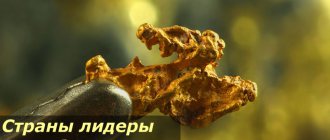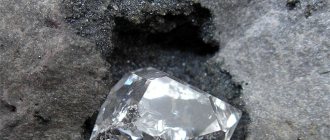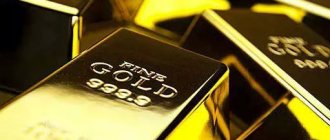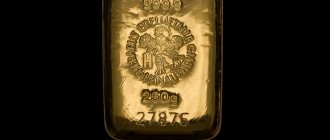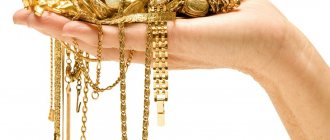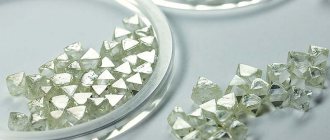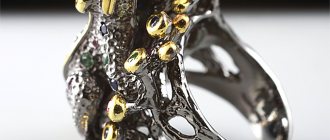What does silver look like in nature?
In nature, it looks far different from what it looks like in a jewelry store. Even in the form of a nugget, a piece of almost pure metal, identifying it as a precious find is not so easy because of the deposit of dark gray sulfide, often with a pinkish tint. It can also resemble a coil of tangled wire or a piece of dry moss, or be in the form of a branching thread-like formation - a dendrite. And it will all be rusty or brownish in color due to the iron hydroxide coating it.
However, silver is most often found not in nuggets, but in the form of ore - a natural mineral raw material, a combination of minerals and bedrock that looks more like stones than metal.
In the case of silver, the compounds can be:
- With gold - electrum. Lamellar formations or dendrites, light yellow, white, greenish, with a metallic sheen, opaque.
- With sulfur - argentite. Solid mass, plates or crystals iron-black, blackish-gray, with a metallic sheen, opaque.
- With lead - galena. Cubic crystals and solid masses, lead-gray with a dull metallic luster, opaque.
- With arsenic - it will make you sad. Solid masses, scarlet, crimson-red, reddish-gray, darken in the light, with a diamond shine, translucent.
- With antimony - pyrargyrite. Granular inclusions, plaque, dendrites, purple-red, with a diamond semi-metallic luster, translucent, translucent.
Sources of recycled silver
The main sources of secondary silver are products from the electrical and radio engineering industries, printing, photography and film industries, products from the mirror, jewelry and watch industries.
From the household sector, sources of precious metal include scrap jewelry , awards and coins.
In radio and electrical engineering, the following are suitable for silver extraction :
- radio components;
- relay;
- contacts of automatic switches and starters;
- batteries;
- contact relays and ceramic capacitors.
Certain types of solders and contacts can contain up to 99% Ag.
Batteries and resistors
Silver-zinc batteries of the SC series, in which the anode is made of pressed silver oxide powder, are distinguished by a high specific silver content.
For example, the battery of the STs-25 model, weighing 470 g (together with the filled electrolyte), contains 85.5 g of Ag, and the STs-110 model, weighing 1.6 kg, contains 559.783 g of Ag.
In small quantities, technical silver is found in the most common resistors of Soviet times, the MLT series (an abbreviation for “metal film varnished heat-resistant”). For example, an MLT-2 product weighing 2.5 grams contains 5 mg of Ag, which corresponds to 0.16% by weight.
Capacitors and relays
Due to the small size and light weight characteristics of radio components containing silver, it is customary to estimate the amount of Ag in terms of 1000 pieces of each group of radio products.
For some types of capacitors and relays, the Ag content per 1000 pcs. following:
- capacitor K15-5 - about 29.9 g;
- capacitor K10-7V - about 13.6 g;
- relay RES6 – 157 g;
- RSCh52 – 688 g;
- RVM – 897
Films
The printing, photography and film industries “provide” worn and damaged film reels and photo prints .
The main raw materials for extracting precious metals are silver bromide and silver sulphide, ash from photographic paper and photographic prints.
Photographic and film films contain silver, the content of which is standardized per 1 square meter. meter _ For example, every sq. a meter of Micrat 300 film contains 4.68 grams of Ag.
Other devices and items
Silver “secondary” coming from the chemical industry is represented by spent catalysts containing up to 80% Ag, sludge, contact masses and scrap silverware.
Silver-containing waste from jewelry production is generated during machining, smelting and chemical processing of precious metals.
In their composition
, they are much poorer than scrap silver and contain from 0.5 to 10% silver, while silver scrap precious metal can contain over 90% (in the case of high-grade jewelry).
Quite a high percentage of silvery precious metal in the “secondary”, coming from watch production .
Silver solders are rich in silver up to 99%, and silver contacts are up to 80%.
Chemical and physical properties
The physical properties of the noble metal are primarily important for production. Due to its high density, pure silver is a fairly heavy substance with a brilliant white color.
Compared to other metals, it has high:
- ability to reflect (making mirrors);
- thermal conductivity;
- electrical conductivity (parts for electrical equipment);
- density, ability to withstand heavy loads.
Among precious metals it differs:
- low melting point;
- high hardness, wear resistance (contact elements of computing equipment);
- softness and plasticity (jewelry making).
The main chemical property of silver as a precious metal is its ability to undergo various types of reactions. It dissolves well in nitric and concentrated sulfuric acid and mercury. It darkens from contact with hydrogen sulfide (including on the human body), reacts to iodine (decorations, cutlery lose their attractive appearance), while in the ground, it is converted into chloride compounds and dissolves.
The process of silver formation in nature
On the surface of the earth, metal is formed during the simultaneous decomposition of sulfur, arsenic and antimony ores and their reduction with a variety of organic compounds.
Moreover, it can take any shape with the exception of a solid mass. Thus, intricate thread-like patterns are formed on pieces of coal. But silver is unstable in such conditions; it quickly turns black and, under the influence of temperature and precipitation, transforms into various compounds.
Underground, most minerals are formed from magma. Due to the tightness at the moment of crystallization, they do not have any special beauty. This is how metal ores, which include silver, are formed.
Another thing is hydrothermal vein deposits. These underground voids, formed by hot aqueous solutions and composed of crystals of quartz, carbonate and lead sulfide, become the site for the extraction of silver wire.
How are silver veins found?
An external sign indicating the presence of a silver vein in the rock is a scattering of rust-colored stones on the flat top of the mountain. This is one way to identify a deposit.
Satellites of silver
Invariably accompanying this metal in vein deposits are argentite, calcite, sulfur, arsenic and antimony compounds of nickel, cobalt, etc.
HEALTH NEWS:
ALL ABOUT SPORTS
Sprains during training: what vitamins will help strengthen muscles and ligaments?
SPORTAuthor: admin4October 29, 2020
Pain during training arises not only from honestly performed work, but also due to various injuries. The most common of these are muscle and ligament sprains. If such seemingly frivolous damage occurs too often, this is a serious cause for concern. After all, as you know, where it is thin, it breaks.
Read more
Reasons to play sports: top 5. Train before it's too late
SPORTAuthor: admin4 September 28, 2018
Things at work, household chores, social networks - all this mercilessly devours our free time. Even going to the gym after 30 years is not easy. At the same time, banal exercises with dumbbells no longer suit you and you want something more. What are the main reasons to play sports? Where can I get the motivation to sign up for a swimming class, martial arts class, or just play…
Read more
ABOUT HEALTH
Exercises that burn the most calories. Speeding up the weight loss process
Weight loss Author: admin4 September 21, 2021
Exercises that burn the most calories will help you quickly get into excellent shape and maintain it. Their list is very diverse and allows lovers of both aerobic and anaerobic exercise to make a choice. However, the optimal combination is cardio and strength training, which allows you to lose weight and form a beautiful muscle profile.
Read more
What to remove from your diet to lose weight
Weight loss Author: admin4 June 30, 2021
What to remove from your diet to lose weight?
This question is asked by millions of people around the world. Diets scare us by having to give up our favorite foods. But are the prohibitions really so categorical? It turns out that if you approach this topic in an organized manner, armed with the necessary knowledge in advance, then proper nutrition will not bring much discomfort. In addition, those who want to lose weight today have special... Read more
Where is silver found in nature?
In nature, the noble metal is found as an admixture of gold-silver, copper and lead-zinc ores. In the earth's crust its content can reach 1 gram per ton - this is most often than all precious metals, and in sea water - 0.00004 g/t.
Types of deposits
In general, there are two types of deposits. These are the silver mines themselves. The share of silver is at least half of the total volume of metals mined. The largest of them are located in Mexico.
There are also silver-bearing deposits, where silver is a small part of the total production. The largest deposits of polymetallic ores are located in Australia, Japan and the USA.
Silver samples
There can be no absolutely pure silver. No matter how carefully it is made, it still contains some amount of impurities. Typically this is most often copper, but nickel, bismuth, iron, lead and antimony are also found. To make special solders, cadmium and zinc are added to the silver composition.
Naturally, the need arises to somehow distinguish alloys of such a precious metal by purity and the presence of impurities. Historically, this problem found its solution in applying a mark to the surface of a silver product indicating the percentage of the base metal - fineness (for example: one kilogram of 925-grade silver contains 925 grams of silver).
It is clear that over such a long period of use in different countries, various samples were applied: from 325 to 1000. There are even unofficial (fake) samples that are often used by scammers (825). However, currently in Russia the following numerical expressions of the percentage of silver are considered officially recognized:
- The alloy of 800 and 830 samples is intended for the manufacture of cheap jewelry and cutlery.
- 875 standard is suitable for decorating interiors, dishes, and making a number of jewelry.
- 925 is sterling silver, from which the vast majority of jewelry sold is made; coins, signs, and interior items are also made.
- 960th - the most expensive jewelry, highly susceptible to deformation.
- 999th – solder – material for technical use, in the form of ingots intended for storage.
Extraction methods
There are four methods of mining:
- Mine - underground. The deposit is developed using a gallery system.
- Quarry - above ground. Mining is carried out in massive trenches.
- Borehole - excavation of ores to the surface using a drill.
- Marine - work below sea level.
In old times
In ancient mines, rock extraction vaguely resembled a combination of modern mining and open pit methods. The extraction consisted of the following: the rock was heated using fires and then sharply cooled. With the advent of explosives, the appearance of mines began to evolve towards the appearance of modern underground mines.
Modern methods
Currently, silver is mined from deposits mainly underground, using the mine method, open-pit mining is also used, and the borehole mining method is increasingly being used.
What happens next to the mined silver?
The next stage of silver production is the separation of the metal from the ore in two possible ways: cyanidation or amalgamation.
In the first case, the entire mined rock is treated with a cyanide alkali solution until it is completely dissolved. Then filter. Add zinc powder. The precipitate that falls is fused. The resulting alloy is sent to a specialized plant to be completely purified from impurities.
In the second method, crushed ore is passed through a mercury solution. Silver reacts with mercury and forms a semi-liquid substance. To extract the metal, mercury is squeezed out, and the resulting solid residue, melted into ingots, is also sent for final purification.
Methods for separating silver from ore
To extract silver, the ore, present in the form of large pieces, is first thoroughly crushed. After which the resulting fraction with dimensions of no more than 5-6 mm is subjected to enrichment using one of the following methods.
Cyanidation
One of the most common ways to isolate a precious mineral is to expose the mineral to cyanide (hydrocyanic acid compounds) together with oxygen to obtain a silver-containing solution. From which, through filtration and sedimentation, silver is deposited at the bottom of the container.
But that is not all. The resulting mass is treated with sulfuric acid to remove unnecessary impurities, and then washed, filtered, evaporated, and melted. As a result of a long technological process, finished silver bars are obtained that are sent for refining.
Amalgation
A process mastered over two thousand years ago and remains relevant to this day. The combination of silver and mercury forms a wet mixture, which is then squeezed out and evaporated. Thus obtaining a solid amalgam, again sent for cleaning to special factories.
Pyrometallurgical method
It should be noted that most of the silver produced in the world (four-fifths of the total amount) is a by-product of the processing of complex ores. The process of pyrometallurgy produces silver-containing compounds of copper, lead and zinc. Using the Parkes, Pattison and cupellation processes, the precious metal is separated from the rest of the chemical elements. Consistently using electrolysis, deposition and annealing.
Grinding and flotation
It is extremely inefficient to use the initially mined ore directly as a raw material, so it is first crushed and floated - separated from the waste rock using a liquid.
Refining
The production of pure silver is called refining, which successively includes a number of listed technological processes:
- Heating in a crucible furnace, carried out to get rid of impurities.
- Pouring the resulting melt into molds - anodes.
- Electrolysis in a solution of nitric acid containing silver nitrate. Since the anodes have already been obtained, stainless steel strips serve as cathodes in this process.
- Melting and casting into ingots.
Areas of application
Each of the physical and chemical properties of silver has found its application in industry and medicine, manufacturing and jewelry.
The ability to withstand heavy loads is used in the manufacture of contact elements in computer technology, electrical engineering and radio electronics.
A special place is occupied by nuclear technology and the defense industry, where silver is used in uranium enrichment.
High thermal and electrical conductivity is in demand in the manufacture of electrical contacts and conductors in precision instruments.
Neutron radiation indicators take advantage of silver's ability to become radioactive.
The ability to reflect is used in the production of mirrors. Photosensitivity is also used by the glasses of “chameleon” glasses and the entire photo and film industry in the production of film.
A colloidal solution of this metal has strong bactericidal properties, which is used by pharmacists in the production of medicines, and by industry in the manufacture of medical devices.
Using silver nitrate, forensic scientists take fingerprints; silver iodide in microscopic quantities causes precipitation. The addition of silver makes the bells and strings sing. And jewelry made from this noble metal can outshine any other!
The whole truth about “silver” water and dishes
Maybe you should stop feeding your child with a silver spoon?
Please tell me, dear reader, did they give you a silver spoon for your first tooth? Or maybe caring grandparents gave such a gift to your child?
My mother bought both of my sons such a cute spoon. I remember when I was little, my parents “silvered” water with the help of products made from this metal. In my eyes it looked like a magical ritual, and I drank the resulting valuable liquid in the hope that it would definitely do something miraculous in my body.
By the way, please note: today household water filters with silver ions are very popular. Almost every self-respecting company producing dietary supplements and cosmetics will definitely prepare something “super-healthy” or “mega-rejuvenating” using “silver” water.
And you probably know about colloidal silver, which is widely used in medicine as a powerful enemy of microbes. My youngest child was only 2 months old when he became very ill. Usually I manage on my own in treating children, but I have never dealt with such kids (the eldest was almost not sick until he was 4 years old) and called a doctor.
A paid pediatrician, whom all my friends praise, prescribed, among other medications, colloidal silver in the nose. Something subconscious stopped me then, and we made do with an ointment based on bee venom. And only then did I receive information that this widely used “precious” drug could be dangerous to health and even life.
What happened with silver is what happens with many phenomena in our lives - once accepted on faith, misconceptions without additional checks are passed on from generation to generation. Then reliable research on this topic appears, but most people continue - apparently out of inertia - to do what they are accustomed to, even if it is dangerous.
Did you know that silver is a heavy metal, which, by the way, along with lead, is in hazard class 3?
In our body, excessive amounts of this substance can replace other vital trace elements in enzymes. For example, it displaces cobalt, which is responsible for metabolism and reproductive function, and also inhibits enzymes that contain copper, since it is its antagonist. After this, the body cells die.
It turns out that silver is a xenobiotic (foreign chemical substance), or, in simple terms, a cellular poison.
For this reason, “silver” water is legally prohibited for use in baby food, as is chlorinated water.
But children continue to be given silver spoons to this day... Not with malicious intent, of course, but out of ignorance. But, as you know, it does not exempt you from responsibility, right?
This is how I immediately attacked the mineral about which I am writing an article in order to present vital information in it. In fact, our body certainly needs it, but in its natural state - obtained from food and from ordinary water, not silver-plated with a spoon and a filter.
Back to contents
Leading countries in production
Today, global silver production amounts to more than 20,000 tons per year, most of it in the leading countries:
- Mexico (5900 t/y)
- Peru (about 4,200 t/y)
- China (more than 3400 t/y)
- Australia (1900 t/y)
- Russia (more than 1600 t/y)
The richest deposits
According to information provided by the US Geological Survey, the largest reserves of silver are: Peru (120 thousand tons), Australia (about 85 thousand tons) and Poland (about 85 thousand tons). The potential of Canada, Germany and Norway is rich in this regard. The Sukhoi Log field in the Irkutsk region is the largest undeveloped reserve in Russia.
Deposits in Russia, compared to the rest of the world, are distinguished by the highest concentration of silver in the ratio of gram of metal per ton of rock.
In the world
Mexico is developing about 200 mines on its territory, the largest of which are in Las Tores (Guanajuato state) and La Encantada (Coahuila state) with deposit volumes of 4.3 and 3.2 million tons of ore, respectively, as well as mines in the states Hidalgo, Zacatecas and Chihuahua with a total production volume of 20% in the country.
In the DPRK, this is the Ying region, which produces 35% of the state's reserves. Next comes Fuwan (Guangdong Province) - this deposit is highly profitable due to the high concentration of silver.
Peru has many small mines, producing 17% of global production. The largest is San Rafael, Eastern Cordillera - about 27% of the country's reserves. Australia - Kirrington, western Queensland. The volume of production at the field is about 43% of the resources of the entire territory.
In Russia
Among the richest deposits operating in the Russian Federation, the following are recognized:
- Lunnoye, Dukat and Goltsovskoye, Magadan region (30% of the country’s production);
- Forecast - Yakutia;
- Ozernoye and Kholodninskoye - Buryatia.
Five large silver mining companies in Russia
- Polymetal Corporation: 800,000 per year, mines of the Khabarovsk Territory and deposits of the Magadan Region, 80% of production.
- Chukotka GGK: Kupol and Dvoinoye fields in Chukotka.
- Millhouse Corporation: Highland Gold Mine.
- .
- .
Precious metal mining in Russia
Silver is mined in Russia where its concentration is sufficient for industrial production. The quantity is enough to satisfy our own needs and sell metal abroad to other countries. Now there are more than 100 mines operating in the country, which are located in 20 regions of the Russian Federation. Statistics can tell which of them are the most productive. Dukat and Lunnoye account for almost 25% of the production of the entire Ural region. Silver reserves in Russia are sufficient to produce more than 1 thousand tons annually.
Almost half of the country's precious metal is produced. Its main activity is mining. The company also conducts exploration work throughout Russia. Other enterprises extract silver as a by-product during the processing of other metals. Russian deposits have reduced argentum content per ton of ore when compared with most foreign ones.
The industry is developing every year, although it is not one of the most profitable for the country. Mining and processing enterprises are gradually beginning to introduce new technologies into the production process. Russia's average annual production is 500−600 tons.
What things and materials can you get silver from?
Precious metal is found in many objects around us. There is especially a lot of it in old things made back in the USSR: tableware, as well as trays and candelabra, Soviet awards, glass Christmas tree decorations of that time, photographic plates and other photographic items.
From radio components and circuits
Soviet-made radio components and circuits are rich in silver, especially in relays and microswitches. From them alone, up to 2-3 grams of high-purity metal can be isolated.
More ways
Nowadays, silver is mined not only in mountain deposits, but also in urban areas. There are large industrial enterprises specializing in the secondary processing of the photosensitive emulsion layer of photographic materials and x-rays.
From the associated effluents of this process, silver is captured in volumes comparable to its extraction from a profitable mine. This way, metal that has already been used once gets a second life.
Pros and cons of mining at home
Extracting metal at home always has a certain degree of risk (working with acids, for example). From the point of view of material enrichment, we must admit: this is not economically profitable, since it is time-consuming and requires a certain amount of reagents, equipment and knowledge.
The main advantage: a high-quality product - silver, the purity of which no manufacturer can guarantee you.
Historical facts about silver
There is a legend that the first silver mines were discovered in 968 by none other than the founder of the Holy Roman Empire, the East Frankish king Otto I the Great. Legend has it that one day the king sent his huntsman into the forest to hunt. During the hunt, he tied the horse to a tree, which, while waiting for the owner, dug up the ground with its hooves, where there were unusual light stones. The emperor realized that this was silver and ordered a mine to be founded at this place. There is evidence that this rich mine was developed six centuries later. This is evidenced by the records of the German physician and metallurgist Georg Agricola (1494–1555). In general, Central Europe was very rich in deposits of silver nuggets. In Saxony in 1477, one of the largest nuggets in history was found weighing up to 20 tons! Millions of European coins were minted from silver mined in the Czech Republic, near the city of Joachimsthal. That’s why they were called “Joachimsthaler”; Over time, the word was shortened to "thaler". In Russia, this name was changed in its own way and here they were called “efimkas”. Silver thalers were the most common European coin in history, hence the modern name "dollar".
Czech Bohemian Joachimsthaler
European silver mines were so rich that silver consumption was measured in tons! But because The bulk of European silver mines were discovered in the 14th-16th centuries, but by now they have already been depleted. After the discovery of America, it turned out that this continent is very rich in silver. Its deposits have been discovered in Chile, Peru and Mexico. Argentina was even named after the Latin name for silver. Here we need to point out a very interesting fact. Geographical names of chemical elements were usually given to an element from the name of a place, for example, hafnium is named after the Latin name of the city of Copenhagen in which it was discovered, the elements polonium, ruthenium, gallium and others have geographical names. Just the opposite happened. The country was named after a chemical element! This is the only such case in history. Silver nuggets are still found in America today. One of them was discovered already in the 20th century in Canada. This nugget was 30 meters long and 18 meters deep! After mastering this nugget, it turned out that it contained 20 tons of pure silver!
How to extract silver at home
- Method one: the silver-containing element is immersed in a mixture of hydrochloric and sulfuric acids. After dissolving it, zinc dust or shavings are added and allowed to settle until a sediment forms, which is washed with water and dried.
- Method two: a little hydrochloric acid is added to the aqueous electrolyte solution. The part sinks to the bottom until a curd-like sediment appears. The precipitate is left to settle for 24 hours, then the solution is filtered and a little hydrochloric acid is added. The acid is removed, the precipitate is washed with water and dried at 120 °C.
- Method three: to remove a thin layer of silvering, it must be treated with a solution of potassium iodide and metallic iodine preheated to 50 °C.
Extracting metal from radio components
The extraction of technical silver from radio components can be carried out using the following algorithm :
- The parts are filled with nitric acid . The acid concentration depends on the expected Ag content in the radio component material.
- As a result of processing, a mixture is obtained that contains silver nitrate. After adding table salt to the mixture, silver nitrate forms silver chloride, which precipitates.
- Zinc powder is added to the agitated sediment , the reaction with which leads to the release of pure Ag. Residues of zinc are removed by adding hydrochloric acid.
- The resulting suspension is filtered using filter paper.
- The silver deposited on the paper is melted down using borax .
- The silver casting is cleaned by washing.
